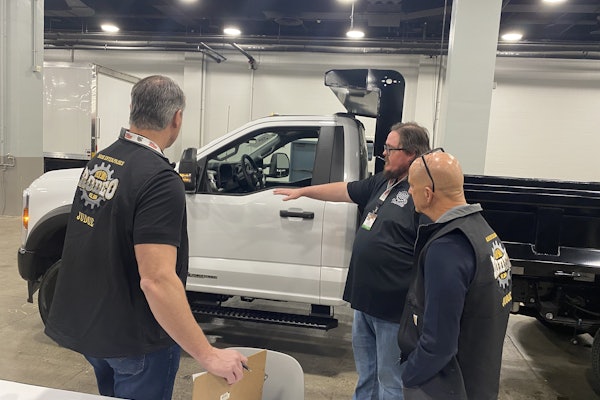It would be difficult to deny the benefits that emerge with the use of air disc brakes. When compared to the widely used S-cam and drum brake systems, the compressing forces of a disc will provide shorter stopping distances, brake applications tend to be more balanced and old friction material usually can be replaced in a fraction of the time.
Most of the worries about brake fade also, well, fade away. Unlike a hot drum that can expand beyond the reach of its friction material, a disc brake’s hot rotors will expand toward the pads.
An increasing number of buyers are “definitely intrigued” by the designs, says Neil Shroff, vice president of business development for DuraBrake, which distributes related components from a variety of suppliers.
Intrigued they may be, but the industry’s buyers have been slow to adopt the equipment. While air disc brakes were first introduced for North America’s trucking industry in the 1980s, they barely account for one percent of the annual brake market’s 2.4 million wheel ends, says Paul Johnston, ArvinMeritor’s senior director, compression and braking. Even when they are purchased, the brakes are largely limited to rescue vehicles, motor coaches, specialty equipment and fleets that want to experiment with the related components.
CHANGE AHEAD?
But we are only a few months away from a decision that could support the wider use of air disc brakes.
The National Highway Traffic Safety Administration (NHTSA) is expected to reduce minimum stopping distances by as much as 30 percent, despite industry lobbying efforts to limit such reductions to 25 percent, explains Aaron Schwass, director of air disc brakes at Bendix Commercial Vehicle Systems. This means a typical 56,470-pound GVW tractor and a non-braked trailer might need to drop from 60 mph to a complete stop within 250 feet. And while most of today’s vehicles still could meet these reduced distances by using larger drum brakes, there are exceptions.
The need for disc brakes could come down to factors that include Gross Axle Weight Ratings, suspension ratings and a vehicle’s wheelbase, explains Randy Petresh, vice president of technical services at Haldex Commercial Vehicle Systems. “Wheelbase is a huge factor in terms of determining dynamic weight transfer.”
Johnson agrees some configurations will present bigger challenges than others, such as the UPS-favored 4×2 tractors with 13,000-pound front axles and 23,000-pound rears. And there are other examples of equipment traveling today’s highways that already require larger drum brakes to meet existing stopping distances.
The latest restrictions – expected to be unveiled before the presidential election – could push more buyers to embrace the disc designs.
THE BENEFITS
These newest users may be surprised by the benefits that emerge in the process.
Unlike the lag times associated with most air brake systems, a disc design offers the firm feedback that is traditionally associated with a passenger car.
The experience with an S-cam brake can vary depending on a vehicle’s speed, but disc brakes offer consistent feedback, adds Ron Plantan, Bendix Commercial Vehicle Systems’ principal engineer, wheel ends.
The systems really shine in the midst of full panic stops. A consistent output ensures that a disc-equipped vehicle will not pull from one side to the other. And the performance of ABS equipment will even be enhanced because the brakes will cycle more quickly than their counterparts.
Because the brakes’ applications are so even, they also can help to extend the life of any drum brakes to the rear. On a typical 6×4 tractor, the use of disc brakes on the leading axle could reduce the wear on the vehicle’s remaining brakes by 15 to 20 percent, says Plantan. The reduced wear could be further enhanced on a 4×2 tractor.
The sealed components found on today’s systems are also less sensitive to water, Petresh adds. “You go through a big puddle with drum brakes and you don’t have any brakes.”
Then there are the advantages for technicians. There is no need to cut and measure push rods. And in many cases, the friction material can even be replaced in under 15 minutes. Compare that to the work on an S-cam brake.
AN EVOLUTION
The performance of disc brakes will be even more surprising to those who experimented with the first designs on the market. When early versions were unveiled, linings wore out too quickly; pistons and caliper slide mechanisms would bind because of vibration, distortion and corrosion; and rotors were prone to checking.
Today’s models are “light years” ahead of their predecessors, agrees Petresh. “There’s absolutely no comparison







